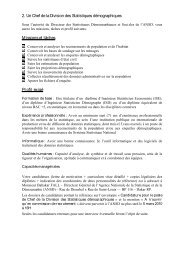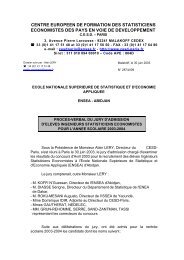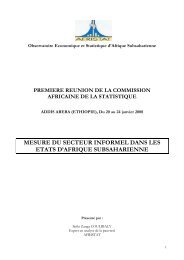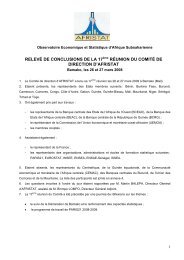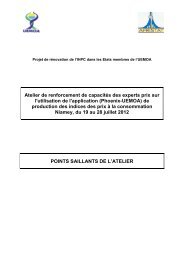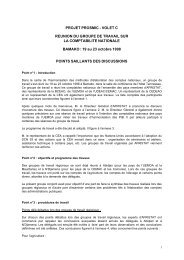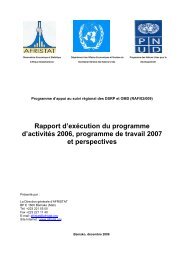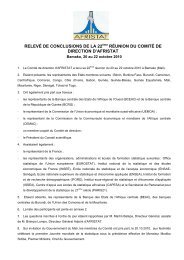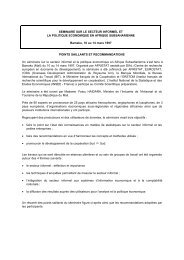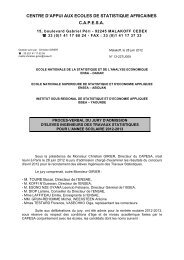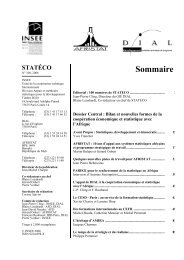Global Purchasing Power Parities and Real Expenditures - Afristat
Global Purchasing Power Parities and Real Expenditures - Afristat
Global Purchasing Power Parities and Real Expenditures - Afristat
Create successful ePaper yourself
Turn your PDF publications into a flip-book with our unique Google optimized e-Paper software.
Tables of Results 77Individual Individual Collective ChangesRestaurants Miscellaneous consumption consumption consumption Gross fixed Machinery inventories Balance of<strong>and</strong> goods <strong>and</strong> Net purchases expenditure expenditure expenditure capital <strong>and</strong> Other <strong>and</strong> exports <strong>and</strong>Education hotels services from abroad by households by government by government formation equipment Construction products valuables imports927 279 326 -199 4,915 290 545 1,261 280 841 141 -10 -1,259574 111 548 87 4,316 681 1,706 2,216 1,142 738 336 10 3,3612,041 176 541 0 9,284 2,065 3,855 17,426 8,265 7,071 2,090 998 18,180924 192 175 193 3,898 1,128 1,613 2,257 977 1,080 199 180 4,56477 21 6 0 1,068 71 99 363 186 178 0 -97 3137 14 45 -1 531 39 62 157 59 93 6 -4 42250 59 94 16 1,648 261 434 709 296 361 51 44 859384 302 624 -2 4,306 635 619 1,562 547 864 151 49 9Individual consumption expenditure by households includes the actual <strong>and</strong> final consumption expenditure incurred by households on individual goods <strong>and</strong> services. It also includes expenditureon individual goods <strong>and</strong> services sold at prices that are not economically significant.Individual consumption expenditure by government includes the actual <strong>and</strong> imputed final consumption expenditure incurred by general government on individual goods <strong>and</strong> services.Collective consumption expenditure by government consists of expenditures incurred by general <strong>and</strong> local governments for collective consumption services such as defense, justice, generaladministration, <strong>and</strong> the protection of the environment.Gross fixed capital formation is measured by the total value of a producer’s acquisitions, less disposals, of fixed assets during the accounting period, plus certain additions to the value of nonproducedassets (such as subsoil assets or major improvements in the quantity, quality, or productivity of l<strong>and</strong>) realized by the productive activity of institutional units.Machinery <strong>and</strong> equipment includes fabricated metal products, general purpose machinery, special purpose machinery, electrical <strong>and</strong> optical equipment, transport equipment, <strong>and</strong> other manufacturedgoods.Construction covers the construction of new structures <strong>and</strong> the renovation of existing structures. Structures include residential buildings, nonresidential buildings, <strong>and</strong> civil engineering works.Other products include products of agriculture, forestry, fisheries, <strong>and</strong> aquaculture, as well as software products.Changes in inventories <strong>and</strong> valuables (including work in progress) consist of changes in (a) stocks of outputs that are still held by the units that produced them before their being further processed,sold, delivered to other units, or used in other ways <strong>and</strong> (b) stocks of products acquired from other units that are intended to be used for intermediate consumption or for resale withoutfurther processing; they are measured by the value of the entries into inventories, less the value of withdrawals <strong>and</strong> the value of any recurrent losses of goods held in inventories. PPPs are notestimated directly; instead, they are imputed using PPPs for consumer goods equipment.Balance of exports <strong>and</strong> imports is the difference in value between the total exports <strong>and</strong> total imports of an economy during a specific period of time.Note:a. Kuwait, Qatar, Saudi Arabia, Yemen, Mauritania, Djibouti, Brunei, Bangladesh, Maldives, Iran, <strong>and</strong> Pakistan do not have expenditures on alcoholic beverages or narcotics.b. Burundi: Submitted prices, but did not provide official national accounts data.c. Egypt, Arab Rep.: Participated in both the Africa <strong>and</strong> Western Asia regions. The results for Egypt from each region were averaged by taking the geometric mean of the PPPs, allowing Egypt tobe shown in each region with the same ranking in the world comparison.d. Zimbabwe: Data were suppressed because of extreme volatility in the official exchange rate.e. China: Results for China were based on national average prices extrapolated by the World Bank <strong>and</strong> ADB using price data for 11 cities submitted by the National Bureau of Statistics for China.The data for China do not include Hong Kong, Macao, <strong>and</strong> Taiwan, China.f. Russian Federation: Participated in both the CIS <strong>and</strong> OECD-Eurostat comparisons. The PPPs for Russia are based on the OECD comparison. They were the basis for linking the CIS comparisonto the Eurostat-OECD program.... Data suppressed because of incompleteness.



